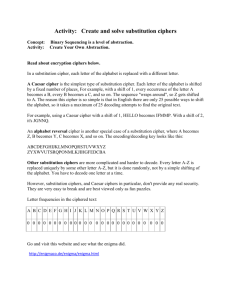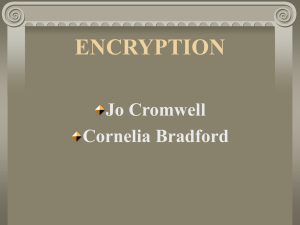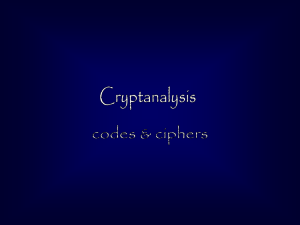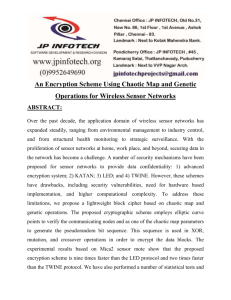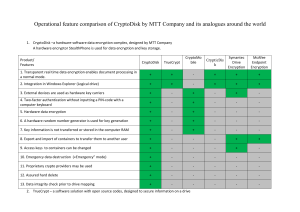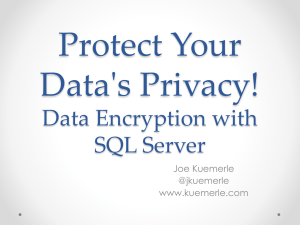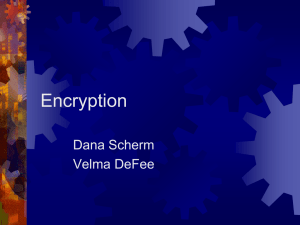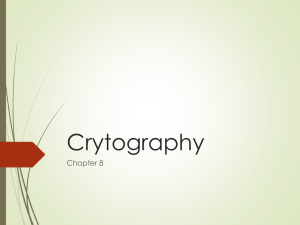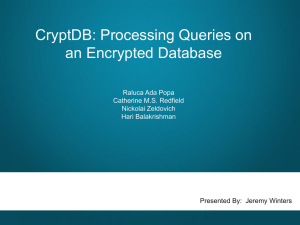ppt - Dave Reed
advertisement
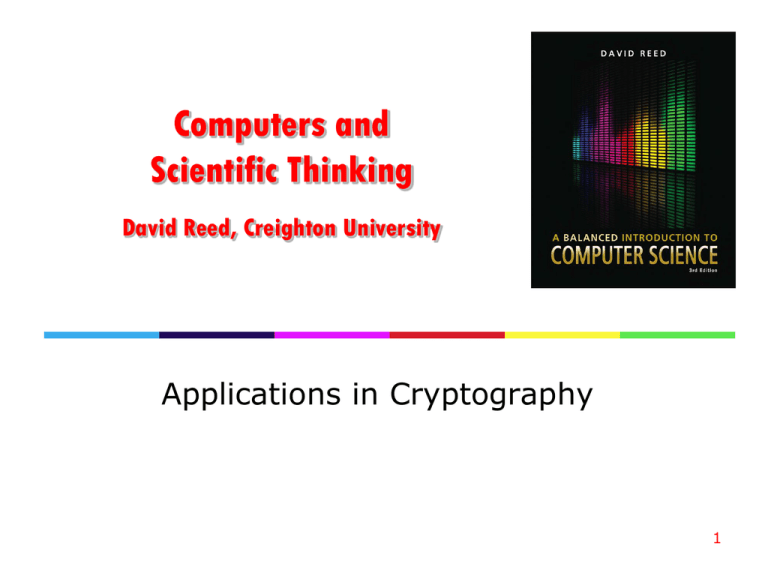
Computers and Scientific Thinking David Reed, Creighton University Applications in Cryptography 1 Cryptography encryption is the process of encoding a message so that it is decipherable only by its intended recipient cryptography is the study of methods for encrypting and decrypting messages the earliest known encryption algorithms are Atbash cipher (500 B.C.), used by Hebrew scribes Caesar cipher (50-60 B.C.), used by Julius Caesar both are known as substitution ciphers, since they substitute one letter for another in the message 2 Substitution Ciphers Atbash cipher substitutes the corresponding letter from the reverse alphabet Caesar cipher substitutes the letter three later in the alphabet (wrapping back around to the beginning) ABC ZYX HELLO SVOOL ABC DEF HELLO KHOOR substitution ciphers are easy to understand and use 3 Encoding a message pseudocode: for as many letters as there are in the message get the next character in the message find its position in the alphabet find the corresponding letter in the key use that letter to encode the current letter in the message 4 Breaking codes in theory, substitution ciphers are reasonably secure 26! ≈ 4 x 1026 possible substitution keys however, patterns in letters provide clues for deducing the key (e.g., letter frequency analysis) Cryptoquotes are common newspaper puzzles that require breaking a substitution cipher to decode a quotation 5 Private-key encryption Atbash & Caesar ciphers are examples of private-key encryption rely on the sender and the recipient sharing a secret key/password must keep that key/password secret, or intercepted messages could be decoded some modern encryption algorithms rely on private keys e.g., Advanced Encryption Standard (AES) was adopted by the U.S. govt in 2001 utilizes 256-bit keys (2256 ≈ 1077 possibilities) 6 Public-Key Encryption private-key encryption assumes that the sender and the recipient have agreed upon some key ahead of time (which introduces other security risks) Whitfield Diffie and Martin Hellman proposed public-key encryption assign each party a pair of associated keys, one is public and the other is private a message encoded with a public key requires the corresponding private key for decoding, and vice versa publi c key 1. Sender encodes the message using the recipient's public key. 3. Recipient decodes the message using the matching private key. 7 Public-Key Encryption virtually all secure communication via the Internet uses public-key encryption e.g., when you purchase something on Amazon the browser communicates with the Amazon server the Amazon server generates a public/private key pair for the transaction, and transmits the public key to the browser the browser encodes credit card & other personal data using the public key the encrypted data is sent to the server, where it can be decoded using the private key a similar exchange occurs between a laptop and wifi router when using a secure wireless network ecommerce often utilizes double encryption to also verify the identity of the sender 8 Encryption in the news the 5th amendment protects a suspect from self-incrimination historically, this has meant that a suspect need not answer questions in an investigation or trial recent cases have brought into question the role of encryption can/should a suspect be forced to provide his/her private key in order to decrypt incriminating data? PROS? CONS? 9 Historical excursion during WWII, the German military used a typewriter-like device called an Enigma machine to encode/decode communications the machine utilized interchangeable rotors with internal circuitry that mapped each letter to another letter (i.e., a substitution cipher) however, the rotors rotated in a complex pattern between letters, yielding a complex, dynamic substitution pattern – thought to be unbreakable 10 Historical excursion efforts to break the Enigma code led to the first electronic computers the Bombe (designed by Alan Turing), and it successor Colossus, were used to generate and test Enigma keys enabled the Allies to break the code for extended periods during the war, achieving immense tactical advantage it is possible to simulate the behavior of a basic Enigma machine using a simple paper model 11

